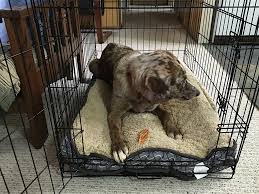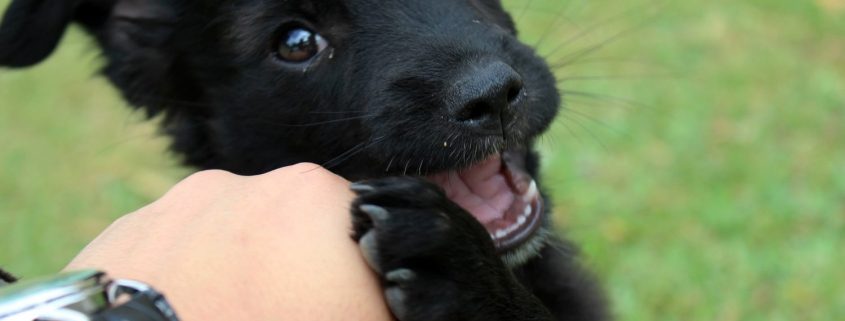Ask Crystal: Should I Crate Train my Puppy?
Welcome to “Ask Crystal,” where you can ask your pet behavior questions! You can submit your question for Crystal at the bottom of the page!

Dear Crystal,
I recently adopted a puppy who is just as sweet as can be. She is extremely active and running around the house all day. She is wearing me out and I can’t keep up with her. Also, I was told I should crate train her and I just haven’t been able to get her used to it. She whines the whole time she is in there and I give up and let her out. I don’t know if it is important or not that she is crate trained. Her housetraining is going pretty well though so I am happy about that. Any suggestions for her energy level?
Sincerely,
Worn out
Dear Worn,
You poor dear! Those puppies are really a lot of work. It’s so easy to forget what our dogs were like as puppies when we get used to the older calm dog sleeping on the couch all day. Puppies seem to have a boundless reservoir of energy that is impossible to deplete. In my opinion, successfully raising a puppy is a delicate balance of exercise, training, enrichment and rest. In this way, we can teach them how to achieve a balanced emotional state.
Crate training has gained a lot of popularity in recent years. My opinion is that in moderation the crate it is a useful tool to have in your toolbox. Most people know it is useful for house breaking and preventing chewing. Beyond those puppy scenarios, there are likely going to be times in your dog’s life when she needs to be in a crate or confined in some way. If your dog ever needs to recover from surgery, do you really want that to be the first time she is ever in a crate? If you like to travel with your dog, you often will be required to crate when you leave the hotel. Eventually, she won’t need to be in it very often but it’s a good idea for her to have some positive experience with it now.
 Another use for the crate is nap time. Puppies like children, often don’t want to go down for a nap that they very much should have. I have put my young dog in her crate for a couple hours at a time during the day while I am at home. She pretty much falls asleep immediately as opposed to constantly running around getting into things. Sometimes we need a break from the puppy antics. It is also to get her used to being in it alone sometimes. One mistake people make is that they only put the dog in the crate when they leave the house. The dog begins to associate the crate with the family leaving which may be a negative experience for her.
Another use for the crate is nap time. Puppies like children, often don’t want to go down for a nap that they very much should have. I have put my young dog in her crate for a couple hours at a time during the day while I am at home. She pretty much falls asleep immediately as opposed to constantly running around getting into things. Sometimes we need a break from the puppy antics. It is also to get her used to being in it alone sometimes. One mistake people make is that they only put the dog in the crate when they leave the house. The dog begins to associate the crate with the family leaving which may be a negative experience for her.
The key to crate training is going at the dog’s pace and making it a fun positive experience for her. People often start closing the door and leaving the dog way too soon. The dog will tell you when they are ready for the next step by being completely happy and comfortable at the step you are at before you move on. Get her used to going in and out on her own by tossing a treat in the crate and saying “yes” as she goes in and tossing another treat in the crate. Let her come out as she wants and repeat. If she has a real aversion to going in the crate, say “yes” for any small movement towards the crate and then toss the treat away from the crate to relieve the pressure. She should slowly start to come closer to the crate. When she seems really comfortable going in, start to work on duration inside the crate with the door open by feeding treats while she is inside. Next step is the closing the door and working on duration with the door closed. Then you will leave the room for a moment and come back and build on the duration away from the crate. It’s definitely a process and the time it takes just depends on the dog.
Once you have spent the time on crate training, you will have to ignore the whining. Be sure to take her outside to potty first so you know she doesn’t need to go potty. If she whines in the middle of the night, take her out once and then put her back and ignore it. If she is panicking, then you need to work on it more or find a different way to confine her. There is a big difference between a little whining and panicking. Usually normal whining will stop once the dog figures out you aren’t going to give in but since you have a history of giving in, it might take longer.
Enrichment feeding is going to go a long way towards expending energy. It can also be a management tool when you can’t pay attention to her. Different dogs like different kinds of enrichment so it is a matter of experimenting with what she likes. In the beginning, she may not seem that into it so try to figure out ways to make it easier or more appealing. You might start with open cardboard boxes with kibble inside and progress to closing the box or using closed cardboard tubes. Giving the dog things to rip up fulfills the need to destroy. Most dogs like frozen canned food so you might start with can food in kongs and then work up to freezing them. You can give her the toys in her crate once you get her used to being in there. Licking at frozen toys is soothing for dogs so it can help teach them to self soothe when you need to leave them alone in the crate.
Puppies should follow the 5-minute rule of 5 minutes of exercise per month of age twice a day. If she were four months old, this would mean two 20-minute walks on level terrain. This is to prevent stress on her growing body. Avoid jogging, jumping or anything too strenuous that could damage your puppy’s joints. Consult with your vet for safe exercise suggestions.
 Play games with your puppy to train her and mentally stimulate her. One of my absolute favorite games is tossing a kibble away from the dog to chase on the carpet and calling them back for another piece. This burns energy and works on the recall. Hide and seek is another great game to get the pup running around the house and works on recalls. Hide in pretty easy places at first so they get the game and then slowly make it harder. The look on her face when she finds you will be priceless! Teach your puppy to search for hidden treats around the house. Again, you will want to start out by making it fairly obvious where you hide the treats and slowly make it harder. I usually put the dog in a stay and then release them and say “find it”.
Play games with your puppy to train her and mentally stimulate her. One of my absolute favorite games is tossing a kibble away from the dog to chase on the carpet and calling them back for another piece. This burns energy and works on the recall. Hide and seek is another great game to get the pup running around the house and works on recalls. Hide in pretty easy places at first so they get the game and then slowly make it harder. The look on her face when she finds you will be priceless! Teach your puppy to search for hidden treats around the house. Again, you will want to start out by making it fairly obvious where you hide the treats and slowly make it harder. I usually put the dog in a stay and then release them and say “find it”.
It is important that we are acknowledging and rewarding calm behavior. Most people only tend to notice when the dog is being naughty and fail to acknowledge and reward the dog for offering appropriate calm behaviors. One technique is to simply notice when your pup is calm and relax and mark the behavior with a clicker or a verbal “yes” and treat. Some dogs don’t seem to offer that type of behavior often so you can also train calm with The Really Real Relaxation Protocol by Suzanne Clothier or the Relaxation Protocol by Dr. Overall.
Training for young dogs should focus on impulse control exercise like wait, leave it and stay. These exercises are extremely practical for keeping your pet safe and managing their behavior. They also teach the dog that you need to learn to wait and behave calmly to get the things you want in life. This is going to be extremely valuable for when she reaches her adolescent teenage years. It is important if you like to live with a polite and well-behaved dog.
By providing for your dog’s mental needs as well as physical needs, you should notice the calm behavior increasing over time. Good luck and happy training!
Until next time,
Crystal







